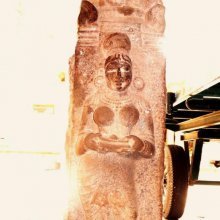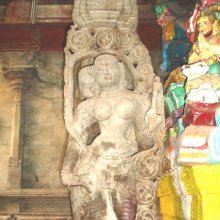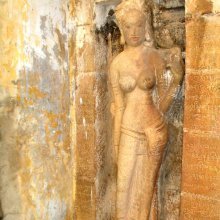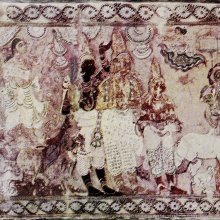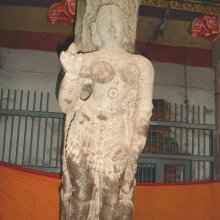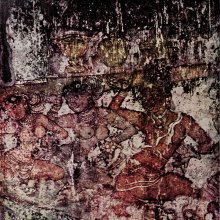Chola, Cholā: 2 definitions
Introduction:
Chola means something in the history of ancient India, biology. If you want to know the exact meaning, history, etymology or English translation of this term then check out the descriptions on this page. Add your comment or reference to a book if you want to contribute to this summary article.
Ambiguity: Although Chola has separate glossary definitions below, it also represents an alternative spelling of the word Cola.
Images (photo gallery)
(+31 more images available)
India history and geography
Source: Shodhganga: The significance of the mūla-beras (history)Chola Dynasty (300 BCE–1279 CE):—The last important phase of art in South India is a mingling of late Chalukya and late Chola art under the Vijayanagara monarchs. A great builder of Chola art and architecture was Kulottunga III (AD 1178-1218). He built the Kampaharesvara Temple at Tribhuvanam and also at Kanchi, Madurai, Chidambaram, Tiruvidaimarudur and Darasuram. Due to the enthusiasm of the Chola kings, Saivism swept over the whole of South India and reached beyond the seas. Thousands of temples were built, giving full rein to the architects and image-makers. This passion was paralleled by a desire to improve the images.
A boom in bronze images marked the Chola period (AD 850-1200). In each temple, though the liṅga remained the central fixed image of worship, there were many movable pieces to be taken out in spectacular processions to stimulate the imagination of the people and help to spread and consolidate the dominant religion. Stone images were not suitable for this purpose and metal ones had to be cast in large numbers. These movable figures were smaller and were mounted on a base, which had either circular holes to thread the poles through, or were provided with lashing rings to secure the image to a litter to be carried in procession.

The history of India traces the identification of countries, villages, towns and other regions of India, as well as mythology, zoology, royal dynasties, rulers, tribes, local festivities and traditions and regional languages. Ancient India enjoyed religious freedom and encourages the path of Dharma, a concept common to Buddhism, Hinduism, and Jainism.
Biology (plants and animals)
Source: Google Books: CRC World Dictionary (Regional names)1) Chola in India is the name of a plant defined with Casuarina equisetifolia in various botanical sources. This page contains potential references in Ayurveda, modern medicine, and other folk traditions or local practices It has the synonym Casuarina equisetifolia L. ex J.R. & G. Forster (among others).
2) Chola is also identified with Cicer arietinum It has the synonym Ononis crotalarioides M.E. Jones, nom. illeg. (etc.).
3) Chola is also identified with Cinnamomum verum It has the synonym Camphora mauritiana Lukman. (etc.).
4) Chola is also identified with Vigna unguiculata It has the synonym Dolichos hastifolius Schnizl. (etc.).
Example references for further research on medicinal uses or toxicity (see latin names for full list):
· Nomenclature et Iconographie des Canneliers et Camphriers (1889)
· Species Plantarum (1753)
· Journ. Arn. Arb. (1950)
· Centuria II. Plantarum (1756)
· Nomenclator Botanicus (1840)
· Flora Indica (1768)
If you are looking for specific details regarding Chola, for example chemical composition, side effects, extract dosage, diet and recipes, pregnancy safety, health benefits, have a look at these references.

This sections includes definitions from the five kingdoms of living things: Animals, Plants, Fungi, Protists and Monera. It will include both the official binomial nomenclature (scientific names usually in Latin) as well as regional spellings and variants.
See also (Relevant definitions)
Starts with (+18): Chola vengai, Cholabengai, Cholabhadra, Choladanya, Choladari, Choladhanna, Cholai, Cholaibiti, Cholaivagai, Cholaka, Cholakin, Cholam, Cholamandalam, Cholanduka, Cholang, Cholanga, Cholangam, Cholarudralksham, Cholavandan, Cholavenga.
Ends with: Anapayachola, Ardhachola, Ban chola, Ban-chola, Battanichola, Chichola, Chinchola, Cola, Machola, Nicchola, Nichola, Picchola, Pichola, Ucchola, Ucchola, Vicchola.
Full-text (+199): Karikala, Kulottunga, Cola, Anuradhapura, Colanatu, Pandya, Polonnaruwa, Kumbakonam, Chola vengai, Ban chola, Vadi, Padi, Corumattu, Cempiyan-tamilavel, Mandala, Niculapuri, Chidambaram, Cempiyan-tamila-peraraiyan, Caparam, Coliyavellalar.
Relevant text
Search found 46 books and stories containing Chola, Cholā; (plurals include: Cholas, Cholās). You can also click to the full overview containing English textual excerpts. Below are direct links for the most relevant articles:
Temples in and around Madurantakam (by B. Mekala)
Later Cholas (in Chengalpattu) < [Chapter 1 - Historical Backdrop]
Transition of Tondaimandalam from the Pallavas to the Cholas < [Chapter 1 - Historical Backdrop]
Rise of Feudatories (in Tondaimandalam) < [Chapter 1 - Historical Backdrop]
The history of Andhra country (1000 AD - 1500 AD) (by Yashoda Devi)
Part 17 - Bhimaraja (A.D. 1214-1233-34) < [Chapter XII - The Pallavas]
Introduction (Chola or Choda dynasty) < [Chapter XX - The Telugu Cholas (Chodas)]
Part 50 - A New Family of the Telugu Cholas (Nellore) < [Chapter XX - The Telugu Cholas (Chodas)]
Middle Chola Temples (by S. R. Balasubrahmanyam)
Later Chola Temples (by S. R. Balasubrahmanyam)
Chapter XV - Rajendra III (A.D. 1246 to 1279/80)
Temples in Kendatti < [Chapter VIII - Temples of Rajaraja II’s Time]
Introduction < [Chapter XVIII - Chola-Hoysala Phase]
Early Chola Temples (by S. R. Balasubrahmanyam)
The Cholas < [Chapter XIII - Prasada: Component Parts]
Temples in Uraiyur < [Chapter X - Historical Survey]
Vastu-shastra (5): Temple Architecture (by D. N. Shukla)
Chola Temples (Circa 900-1150 A.D.) < [Chapter 12 - History of Hindu Temples (Prāsādas and Vimānas)]
Temple architecture in Ceylon (Sri Lanka) < [Chapter 12 - History of Hindu Temples (Prāsādas and Vimānas)]
Kailāśa-nātha and Vaikuṇṭha Perumal < [Chapter 12 - History of Hindu Temples (Prāsādas and Vimānas)]
